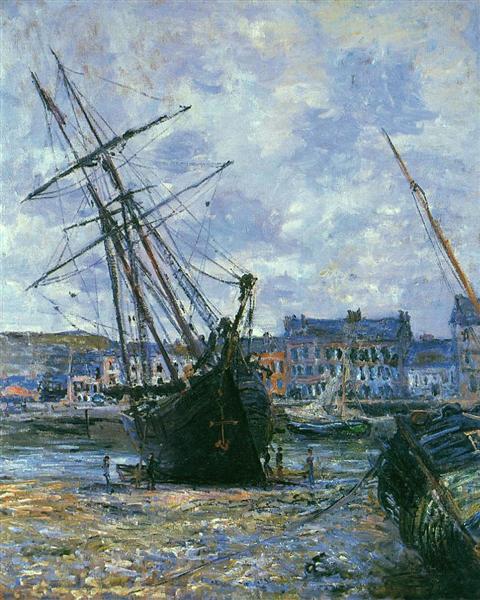Descrição
O trabalho "Barcos que situam -se durante a maré baixa em Facamp" de 1881, criados por Claude Monet, é um exemplo sublime da capacidade do pintor de capturar a essência de um instante e a interação entre luz, água e natureza. Monet, figura central do movimento impressionista, dedicou grande parte de sua carreira a explorar e representar a beleza efêmera da paisagem, e este trabalho não é exceção. A pintura Ele reflete uma cena diária do porto de Fécmp, na Normandía, onde os navios atordoados oferecem uma visão fascinante da vida marítima.
Ao observar a composição, a primeira coisa que atrai a atenção é a disposição dos navios. Eles estão deitados na areia, expostos à maré baixa, e sua forma e ângulo parecem interagir com o horizonte. Esse uso do espaço é característico de Monet, que muitas vezes experimentou perspectivas incomuns que pegam o olhar do espectador. A escolha de representar navios em um momento de inatividade contrasta com a representação tradicional da vida marinha, onde o movimento e a atividade são enfatizados.
O jogo de cores no trabalho é igualmente notável. Monet usa uma paleta que cobre tons macios e sutis, do azul revitalizante que evocam o oceano até o bege e o marrom da areia. Esse uso de cores não apenas explica a luz do sol refletida nas superfícies, mas também cria uma atmosfera de tranquilidade. As pinceladas soltas e rápidas que caracterizam seus trabalhos transmitem uma sensação de imediatismo e frescura, como se o espectador pudesse quase ouvir o murmúrio das ondas.
Sim ok a pintura Falta personagens humanos, a presença de navios evoca a atividade daqueles que os usam diariamente. A ausência de figuras humanas permite que a atenção do espectador se concentre completamente na relação entre céu, água e terra. Nesse sentido, Monet alcança uma conexão emocional com a experiência da paisagem, sugerindo que, embora os navios ainda estejam, a vida e o movimento estão intrinsecamente ligados à sua existência.
"Os barcos situados durante a maré baixa em Facamp" estão em um contexto maior no trabalho e no impressionismo de Monet. Ao longo de sua carreira, Monet mostrou um interesse particular em condições de luz e como eles poderiam mudar a percepção da paisagem. Trabalhos semelhantes, como "Impressão, Sol Rising" ou "Los Nenufares", refletem esse compromisso com a luz e seu efeito nas cores e formas. A atenção ao momento presente e às variações atmosféricas se torna um fio condutor nas obras de Monet, e este pintura É um exemplo eloqüente dessa exploração.
Em termos de história, este pintura Não apenas se destaca por sua beleza estética, mas também por sua capacidade de evocar um senso de lugar e vida cotidiana em um período de grande transformação em a pintura. Monet, como muitos de seus contemporâneos, desafiou as convicções artísticas tradicionais de seu tempo, buscando capturar o efêmero e o visceral através do uso inovador de luz e cor. "Os barcos situados durante a maré baixa em Facamp" exemplifica essa pesquisa, oferecendo ao espectador não apenas uma imagem impressionante, mas também uma reflexão profunda sobre a interação da humanidade com seu ambiente natural.
Em conclusão, esta obra -prima de Monet é uma celebração da natureza e uma meditação sobre o passar do tempo. Com sua complexidade visual e suas sutis nuances, convida o espectador a contemplar não apenas a beleza da paisagem marinha, mas também a riqueza da experiência humana em comunhão com o mundo natural. A pintura É um lembrete do talento de Monet para transformar a vida cotidiana em arte, tornando cada momento um trabalho digno de ser valorizado.
KUADROS ©, um pintura famoso em sua parede.
Reproduções de pinturas petróleo feito à mão, com a qualidade dos artistas profissionais e o selo distinto de KUADROS ©.
Serviço de reprodução de imagens com garantia de satisfação. Se você não está completamente satisfeito com a réplica de seu pintura, Reembolsamos seu dinheiro 100%.

